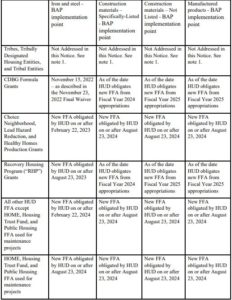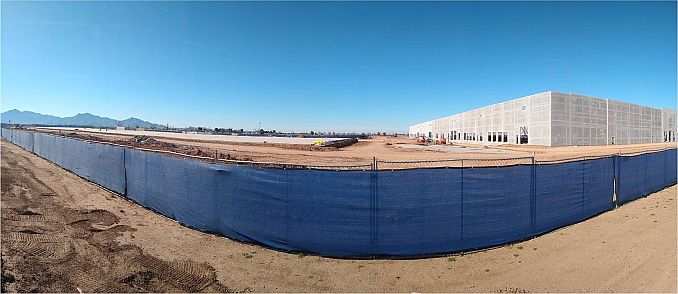
With the advent of the OMB’s (Office of Management and Budget) updated guidance and waiver process to implement the “Build America, Buy America” program, it is hard to believe housing and development of all sorts won’t be further delayed and more expensive. Basically, the rule says there is a preference for U.S. manufactured materials in construction of infrastructure when federal finance assistance is used.
Think of infrastructure needed or in need of repair or expansion, and the several trillions of dollars committed within legislation the past two years: broadband, water, roadways, manufacturing, infrastructure of all kinds – almost everything we see is affected and housing too.
The reality is America decided in the 1990’s to disband its manufacturing base.
My concern arises from the basic fact the U.S. no longer has the mining or manufacturing backbone to make 100% of all items required for construction and manufacturing. Yet, the “Build America, Buy America” preference requires this.
The list of projects affected by this rule is vast. Public infrastructure under this rule includes “structures, facilities, and equipment for: roads, highways, bridges; public transportation, dams, ports, harbors, other maritime facilities; intercity passenger and freight railroads; freight and intermodal facilities; airports; water systems; drinking water and wastewater systems; electrical transmission facilities and systems; utilities; broadband infrastructure; and buildings and real property (including housing)”. Equipment that generates, transports or distributes energy (includes EVs and EV charging).
Each agency of the federal government has released its grant funding along with the rules under OMB. There is a waiver provision, but my reading is waivers are complicated and, based on waivers of some of the solar and wind projects (17 years), it may take several years to receive a waiver or the waiver may not be long enough to accommodate industrial and manufacturing reality.
The most recent guidance released by OMB is phase one of a multi phase implementation. After reading the OMB’s guidance and various agency specific guidance, you may be asking “How do communities pay for needed improvements?” It does seem that improvements will be difficult since America no longer provides the full spectrum of product materials, manufacturing, or distribution. Below are a few examples from my reading of the Act, OMB guidance, the Federal Register, and agency implementation rules:
The OMB does not provide an exact definition of construction materials in the February 9, 2023 Federal Register Notice of Proposed Rulemaking, Guidance for Grants and Agreements. They do provide standards for construction materials to determine if the materials are produced in the U.S. There is a long section on determining de minimis additions, defining predominantly iron or steel items, the meaning of composite building materials, and the cost of components.
The OMB defines an infrastructure project subject to the Buy America preference as “…any activity related to construction, alteration, maintenance, or repair of infrastructure in the United States regardless of whether infrastructure is the primary purpose of the project.”
Construction materials is defined as “articles, materials, supplies incorporated into an infrastructure project that consist of only one or more of the following materials:
- Non-ferrous metals
- Plastic and polymer based composite products (including polymers used in fiber optic cables)
Glass (including optic glass) - Fiber optic cable
- Optical fiber
- Lumber
- Drywall
Here are examples of the standards:
Non-ferrous metals: All manufacturing processes from initial smelting or melting through final shaping, coating and assembly occurred in the United States.
My concern: The United States has only 3 copper smelters. They are all over capacity and have been for several years.
Fiber optic cable: All manufacturing processes, from the initial preform fabrication stage through fiber stranding and jacketing, occurred in the United States.
My concerns: It is readily apparent by a quick reading of the Wall Street Journal or various other
newspapers and industry publications; the United States does not have the ability to meet this
requirement. China provides the U.S. with a lot of the fiber optic materials.
Glass: All manufacturing processes, from initial batching and melting of raw materials through annealing, cooling, and cutting.
My concerns: With imported raw materials a part of glass manufacturing in the U.S., what is the
ability of domestic glass manufacturers to meet the growing demand for glass and still conform to the OMB’s rule? I don’t know if solar panels fall under glass, but if so, the top 4 producers of solar panels are Chinese and China produces a large amount of the minerals needed to make these panels.
Drywall: All manufacturing processes, from initial blending of mined or synthetic gypsum plaster and additives through cutting and drying of sandwiched panels, occurred in the United States.
My concerns: While drywall is a concern as China controls large amounts of gypsum, a key component
in drywall, the various products that fall under the category of gypsum board products include sheathing, water/moisture resistant board, 5/16 mobile home board and others. The U.S. imported 6,890 metric tons of gypsum in 2022 and 1,840 metric tons in Q1 2023 according to the Department of Interior USGS stats. According to USGS, the United States imported Gypsum from three main sources: Mexico (35%),Spain (33%), and Canada (28%).
There are more items of concern and more construction materials outlined in the OMB guidance.
I looked at an example of one type of grant project to get an idea of what is to come. Last year (2022) the federal government made several middle mile broadband grants available to rural communities to extend and build broadband infrastructure. The waiver I found from the Department of Commerce dated April 5, 2023 provides insight into the agency processes. Here are a few excerpts:
Excerpt 1

Excerpt 2
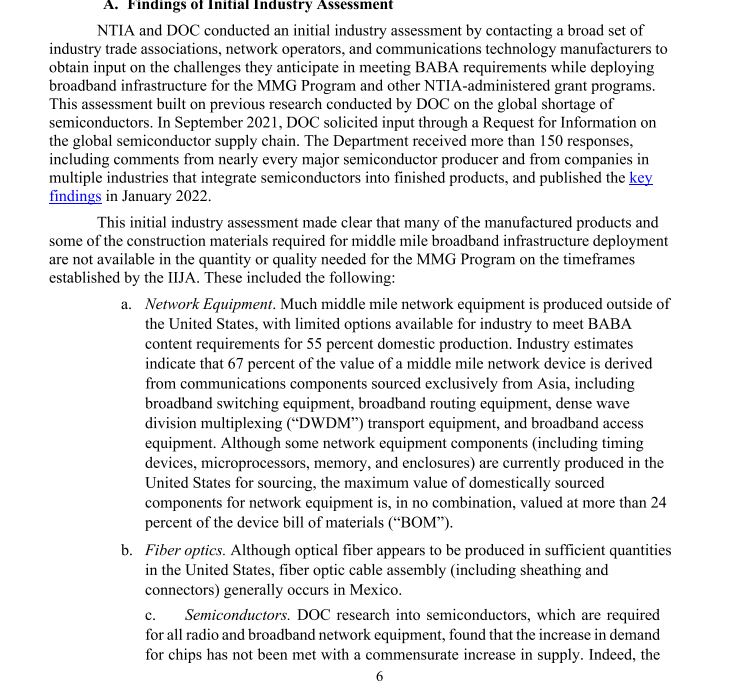
Excerpt 3
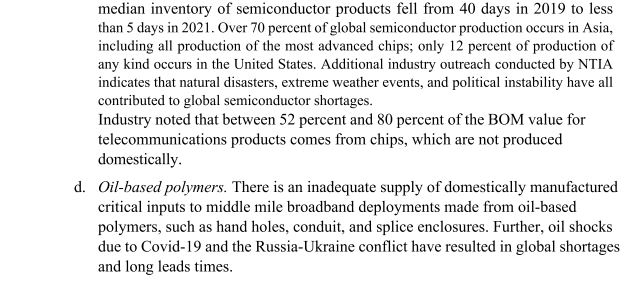
Excerpt 4
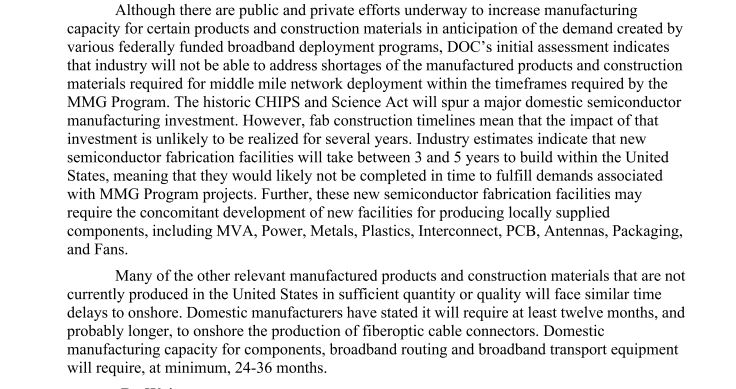
The document concludes with the effective date of this waiver being March 1, 2023 until March 1, 2024.
HUD has released waivers as well, but they appear to be limited and may not be relied upon if another federal agency does not provide the same waiver status. It is possible for HUD to provide a waiver for a specific requirement, but the requirement would still be necessary under the other agency.
VI. Impact of this Waiver on other Federal Financial Assistance
Where the BAP or other BABA requirements are made applicable to projects of a grantee or funding recipient by another Federal agency, the grantee or funding recipient may not rely on this waiver as a waiver of any requirement imposed by the other Federal agency for the projects, nor is the grantee or funding recipient exempt from the application of those requirements in accordance with the requirements of the Federal agency providing such Federal Financial Assistance.
HUD released its implementation schedule for housing using Federal Financial Assistance programs like CDBG and RHP grants.
Another source of restriction may be the type of loan the buyer intends to use. The federal government defines Federal Financial Assistance as:
Title VI regulations define the term “Federal financial assistance” broadly to include:
1. grants and loans of Federal funds,
2. the grant or donation of Federal property and interests in property,
3. the detail of Federal personnel,
4. the sale and lease of, and permission to use Federal property or interest in such property without consideration or at a nominal consideration, and
5. any Federal agreement, arrangement, or other contract which has as one of its purposes the provision of assistance. 45 C.F.R. § 80.13(f).Thus, “Federal financial assistance” means assistance in the form of any grant, loan, or contract (other than a contract of insurance or guaranty). See 42 U.S.C. § 2000d-4. This includes use of equipment, donations of surplus property, and other forms of assistance.
So, what does this mean for homebuyers with federally backed loans or down payment assistance? What does it mean for federally funded rental housing?
I can’t say precisely, but working with a lender early is advisable. Whether your client is a renter or homebuyer, watching the phased implementation is important as more properties are affected throughout 2023. Your client may wish to consult an attorney or other expert.
Additional Resources:
HUD BAP Recipients HUD Federal Financial Assistance Docket No. 6331-N-10
HUD BAP Recipients HUD Federal Financial Assistance Docket No. 6331-N-10A
HUD Waiver Recipients of HUD Federal Financial Assistance Docket No FR-6331-N-06
HUD Waiver for Exigent Circumstances Docket No FR-6331-N-05
HUD De Minimis and Small Grant Waiver Docket No FR-6331-N-08

